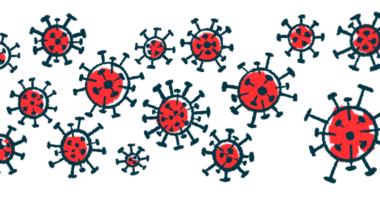Iloprost Reduces Release of CXCL10, a Driver of Inflammation in SSc
Researchers tested molecule's effects on fibroblasts, endothelial cells

The release of CXCL10 — an inflammatory signaling molecule associated with a worse prognosis in scleroderma — from connective tissue cells and those lining blood vessel walls was significantly weakened with iloprost, a recent study reports.
These findings showcase the added benefits of iloprost, commonly used to widen blood vessels and improve blood circulation, in treating scleroderma’s early stages.
The study, “The Prostacyclin Analogue Iloprost Modulates CXCL10 in Systemic Sclerosis,” was published in the International Journal of Molecular Sciences.
Systemic sclerosis (SSc), or scleroderma, is an autoimmune disease marked by extensive blood vessel impairment and tissue scarring, most often affecting the skin. Most patients develop Raynaud’s phenomenon, wherein the fingers and toes become numb and cold in response to low temperatures or stress. Raynaud’s is often accompanied by pain and ulcers on the fingers and toes.
CXCL10 is a small signaling molecule known to boost inflammation. Elevated levels of it in SSc patients have been linked to disease progression and a worsening prognosis.
When infused into the bloodstream, iloprost acts as a vasodilator — an agent that promotes blood vessel widening — and is recommended by the the European League Against Rheumatism (EULAR) for SSc-related Raynaud’s and skin ulcers when patients fail to respond to oral vasodilators.
Iloprost is marketed in the U.S. as Ventavis, an inhaled formulation administered with a nebulizer. Its active ingredient is a lab-made version of prostacyclin, a naturally occurring hormone that relaxes and widens blood vessels. By binding to the prostacyclin receptor, iloprost activates a signaling pathway that’s thought to help lower CXCL10 levels.
Iloprost’s effect on fibroblasts, endothelial cells
A team led by researchers in Italy evaluated its effects on releasing CXCL10 from different cell types grown in the lab (in vitro).
They used human endothelial cells, which line blood vessel walls, from the aortas of developing fetuses and human dermal (skin) fibroblasts — cells found in connective tissue that contribute to scarring, or fibrosis. The aorta is the main artery that carries blood away from the heart to the rest of the body.
CXCL10 release was induced by exposing cells to two signaling molecules: interferon (IFN)-gamma and tumor necrosis factor (TNF)-alpha.
Iloprost significantly reduced the release of CXCL10 by nearly half in endothelial cells (from 1,720 to 1,003.5 picograms per microgram (pg/mcg) and in fibroblasts (from 1,387 to 721.8 pg/mcg). No decrease was seen in cells that weren’t exposed to iloprost and were used as controls.
Iloprost prevented the activation of key downstream players of IFN-gamma and TNF-alpha signaling only in endothelial cells, molecular analyses showed. These molecules included the inflammatory mediators STAT1, NF-kB, and ERK1/2. Results showed iloprost inhibited STAT1 by 93.1%, NF-kB by 92%, and ERK1/2 by 26.9%.
In fibroblasts, iloprost had no direct effect on IFN-gamma and TNF-alpha dependent pathways.
Further assays using specific chemical inhibitors of NF-kB and ERK1/2 confirmed these were the two major players involved in the release of CXCL10 in each cell type (NF-kB in endothelial cells, ERK1/2 in fibroblasts).
In endothelial cells, blocking ERK1/2 and another molecule called JNK, also decreased the release of CXCL10 — by 64.4% (ERK1/2) and 77.6% (JNK). In fibroblasts, blocking NF-kB lowered the release of CXCL10 by 83.3% and blocking JNK, by 74.7%.
Finally, researchers evaluated iloprost’s effectiveness at reducing blood levels of CXCL10 in SSc patients. They measured CXCL10 levels in patients treated with iloprost alone (seven patients), or in combination with disease-modifying anti-rheumatic drugs (DMARDs) (nine patients), or corticosteroids (nine patients). A total of 20 SSc patients matched for age and sex who received no treatment were included as controls.
The analysis revealed that, compared with untreated controls, all patient groups had significantly lower levels of CXCL10 in circulation.
While DMARDs and corticosteroids mainly act on immune cells, iloprost could help lower CXCL10 release from local tissues, namely blood vessels, which are normally affected in the disease’s early stages, the researchers said.
“Iloprost, in addition to the well-known vasodilator effect, can counteract CXCL10 release by human endothelial cells and fibroblasts … might open new scenarios for early treatments in SSc,” they wrote.







